This article was co-authored by Dina Garcia, RD, LDN, CLT. Dina Garcia is a Registered Dietitian, Nutritionist, and the Founder of Vida Nutrition and Conscious Living, her private practice based in Miami, Florida. Dina specializes in helping yo-yo dieters and binge eaters overcome food guilt, practice self-love, and rediscover self confidence. She has over 15 years as a dietitian. She received a BS in Dietetics from Ball State University and completed her supervised dietician practice at California State University, Fresno. She is certified as a Registered Dietitian (RD) by the Commission on Dietetic Registration and is a Florida Licensed Dietician/Nutritionist (LDN).
There are 8 references cited in this article, which can be found at the bottom of the page.
This article has been viewed 134,954 times.
Although everybody has favorite foods and different calorie and nutrient needs for their individual bodies, basic strategies for putting together a balanced meal can benefit everyone. Balanced meals provide necessary nutrients from different food groups, and can even assist in losing weight, boosting heart health, and reducing the risk or side effects of many common chronic health conditions.
Steps
Choosing Food from Different Food Groups
-
1Make half your plate consist of vegetables and fruits. Choose whole fruits and vegetables to consist of one half of any balanced meal. Try for 1 – 2 cups of fruit and 2 – 3 cups of vegetables per day.[1] [2]
- Whole fruits and vegetables can include fresh, frozen, or canned items with no other ingredients (like sugar or salt) added.
- Equivalents of 1 cup of fresh fruit would be 1 cup of 100% fruit juice or ½ cup of dried fruit. Equivalents of 1 cup of fresh raw or cooked vegetables would be 1 cup of vegetable juice or 2 cups of leafy greens.
- Choose vegetables from all five subgroups: dark green vegetables, red and orange vegetables, legumes (beans and peas), starchy vegetables, and other vegetables.
-
2Aim for whole grains. Make about a quarter of any balanced meal consist of grains, with at least half of those grains being whole rather than refined. Grains include food made from wheat, rice, oats, cornmeal, barley or another cereal grain.
- Easy examples of foods that fall into the grain category are bread, pasta, oatmeal, breakfast cereals, tortillas, and grits.
- Whole grains are any grains that use the entire grain kernel, such as whole wheat flour, brown rice, oatmeal, whole cornmeal, and bulgur wheat. Look for “whole wheat” on the labels of food you eat, and favor these items over refined wheat products like white bread, white rice, etc.[3]
- Aim for a minimum of 3 – 4 ounces of grain foods per day, or a recommended amount of 6-8 ounces. 1 ounce could be a ½ cup of pasta, rice, or oatmeal; one slice of bread; ½ an English muffin; or 1 cup of whole grain cold cereal.
Advertisement -
3Vary your protein sources. Choose proteins from a variety of different food sources for the healthiest level of nutrients. Aim for proteins to take up about a quarter of your plate for any balanced meal.
- Eat both animal proteins and plant proteins. Animal proteins include meat, poultry, seafood, and eggs. Plant proteins include beans and peas, nuts, seeds, and soy. Choose different plant and animal proteins for each meal or day so that you get a wide variety.
- Aim for about 5 – 6 ounces of protein foods per day. 1 ounce of protein could look like 1 ounce of lean meat, poultry, or fish, or a ¼ cup cooked beans or tofu.[4]
- Note that proteins like seafood, nuts, and seeds can also be good sources of oils, which are another essential addition to balancing a meal.
- Look for meat and poultry that are low in fat and added sodium. Eat unsalted nuts and seeds.
-
4Add some low-fat dairy. Drink or eat milk products to receive the calcium and other nutrients present in cow's milk. Favor low-fat versions to reduce fat intake.
- Aim for about 3 cups of dairy per day. A cup of dairy could mean 1 cup of milk, yogurt, or soymilk; 1 and ½ ounces of natural cheese; or 2 ounces of processed cheese.
- Dairy products are generally considered to be all foods made from cow's milk; however, products like butter, cream cheese, and cream are not generally considered part of this food group for nutritional purposes due to their low calcium content.[5] And butter and cream are really made from fat.
Making Balanced Meals
-
1Eat a substantial breakfast. Keep your morning meal balanced with enough food to represent a variety of food groups and start your metabolism working for the day.
- Start with milk and cold or hot cereal, then top with pieces of fruit and nuts or seeds to create an easy breakfast that contains grains, dairy, fruit, and protein. Avoid sugary cereals or sweetened fruits.
- For a hot breakfast, try an omelet with two eggs or ½ cup of egg substitute; ½ cup of vegetables (like chopped broccoli, bell pepper, and onion, for example); and 1 ounce of reduced-fat cheese. Serve with a whole grain English muffin.[6]
-
2Plan ahead for lunches and dinners. Buy ingredients for healthy meals for the week ahead of time. Prep several portions of food to eat throughout the week, or eat dinner leftovers for lunch the next day, for a way to save time but still eat well.[7]
- For a quick lunch, try a sandwich with two slices of whole grain bread, lettuce, onion, tomato, a slice of low-fat cheddar cheese, and a few slices of lunch meat. A side salad with two tablespoons of salad dressing and a single cup of 100% fruit juice could complete the meal.
- For a simple balanced dinner, try 1 cup of cooked carrots, 1 cup of steamed string beans, 1 cup of cooked brown rice, and a single grilled pork chop. Water or low-fat milk could serve as a healthy drink.
- When planning meals and shopping for ingredients, reduce or eliminate pre-packaged or prepared foods, sodas, salty snacks, and dessert foods. You're more likely to make balanced meals when healthy, whole foods are on hand, without substituting for easy processed foods.
-
3Remember to balance snacks. Don't forget to make snacks between meals as balanced as possible. You may not include all food groups in every small snack, but each snack should contain more than one type of food.
- For example, try a snack of apple slices and celery sticks with peanut butter to dip them in for a healthy snack that contains, fruit, vegetables, and some protein and oil.
- Eating snacks can be a great way to get a full day's worth of balanced nutrients if you get hungry between meals or have trouble eating substantial meals to contain enough food from each food group.
Customizing Your Meal Requirements
-
1Calculate the number of calories you need. Determine the unique number of calories you need and quantity of foods you should have based on your age, sex, size, and activity level. Tailor your meals to fit the USDA recommendations based on these factors.[8]
- Consider that your “ideal” number of calories or portion sizes can change considerably, or be altered by a need or desire to lose or gain weight, get more of a key nutrient you're deficient in, or other specific health factors.
- Every meal should remain balanced with proportional amounts of food from different food groups. Don't substitute large amounts of protein just to get more calories, for example, or completely cut out a food group if you're trying for less calories.
-
2Always consult a doctor about health conditions. Go to the doctor regularly, and discuss any acute or chronic health conditions you may have. Ask questions about the foods you should be eating or avoiding due to the condition, which may alter the portions of your typical balanced meal.
- For example, diabetics may be advised to opt for whole grains over refined grains and restrict their dietary intake of fruits and fruit juices. Those with high cholesterol and heart disease may make animal products and fatty foods a smaller amount of their daily intake. Those needing to lose weight may put a heavier emphasis on vegetables and reduce the use of butter, oil, shortening, sugar, or salt when cooking.
- Never assume an alteration to your diet based on general knowledge of a health condition is right for you until you consult a health professional about it.
-
3Make substitutions for allergy or other restrictions. Take allergens into consideration if you have a bad reaction to any types of food. You may also need to eliminate or substitute foods based on other health conditions.
- If you are lactose intolerant, include lactose-free or lactose-reduced dairy products, or substitute cow's milk for non-dairy milks such as those made with almond, soy, coconut, rice, etc. Look for calcium-fortified foods and beverages, or foods naturally high in calcium like sardines, tofu, tempeh, kale, collard greens, and other leafy greens.
- If you are a vegetarian or have other restrictions on animal products, eat more plant proteins like beans and peas, nuts and seeds, and soy products to account for your daily protein intake.
- Keep meals balanced as best as you can given any other elimination or restriction of allergens. Consult with a doctor or dietician to get recommendations on how to meet nutrition requirements with your specific limitations.
Expert Q&A
Did you know you can get expert answers for this article?
Unlock expert answers by supporting wikiHow
-
QuestionWhat is the simplest way of balancing meals?
 Dina Garcia, RD, LDN, CLTDina Garcia is a Registered Dietitian, Nutritionist, and the Founder of Vida Nutrition and Conscious Living, her private practice based in Miami, Florida. Dina specializes in helping yo-yo dieters and binge eaters overcome food guilt, practice self-love, and rediscover self confidence. She has over 15 years as a dietitian. She received a BS in Dietetics from Ball State University and completed her supervised dietician practice at California State University, Fresno. She is certified as a Registered Dietitian (RD) by the Commission on Dietetic Registration and is a Florida Licensed Dietician/Nutritionist (LDN).
Dina Garcia, RD, LDN, CLTDina Garcia is a Registered Dietitian, Nutritionist, and the Founder of Vida Nutrition and Conscious Living, her private practice based in Miami, Florida. Dina specializes in helping yo-yo dieters and binge eaters overcome food guilt, practice self-love, and rediscover self confidence. She has over 15 years as a dietitian. She received a BS in Dietetics from Ball State University and completed her supervised dietician practice at California State University, Fresno. She is certified as a Registered Dietitian (RD) by the Commission on Dietetic Registration and is a Florida Licensed Dietician/Nutritionist (LDN).
Registered Dietitian-Nutritionist
Warnings
- No one dietary guideline is right for everyone. Try new meals, consult a doctor or dietician regularly, and update your food quantities over time to find the diet that is right for you in different phases of your life or health.⧼thumbs_response⧽
- Avoid diet programs that advocate the total elimination of a basic food group, in general, unless recommended after consulting a health professional. For most individuals, a wide variety of foods with high nutrient content and low calorie and fat contents can provide better nutrition while still promoting weight loss.⧼thumbs_response⧽
References
- ↑ http://www.choosemyplate.gov/fruit
- ↑ http://www.choosemyplate.gov/vegetables
- ↑ http://www.choosemyplate.gov/grains
- ↑ https://www.betterhealth.vic.gov.au/health/healthyliving/breakfast
- ↑ http://www.choosemyplate.gov/dairy
- ↑ http://www.webmd.com/food-recipes/healthy-breakfast-ideas-and-recipes?page=3
- ↑ http://www.huffingtonpost.com/alan-kohll/how-to-pack-a-healthy-lunch-for-work_b_8839046.html
- ↑ https://tdeecalculator.net
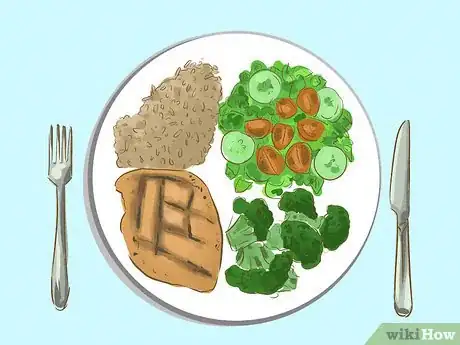
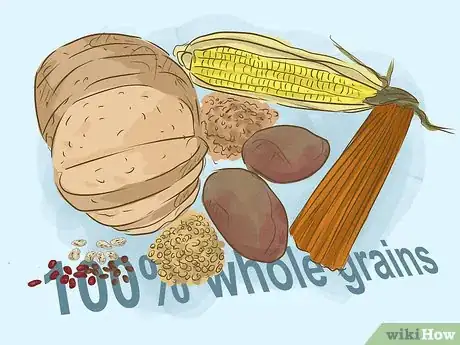
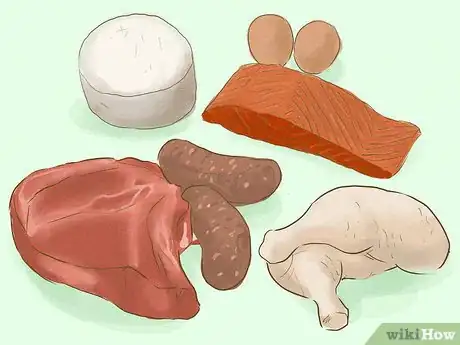
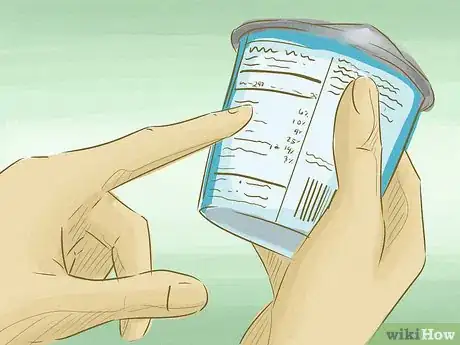
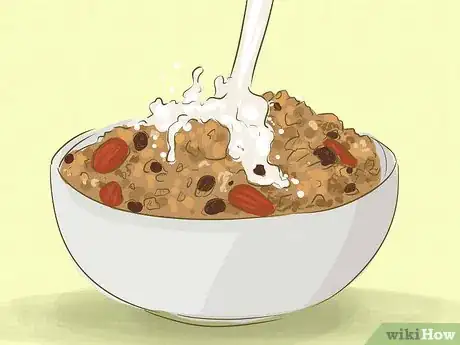


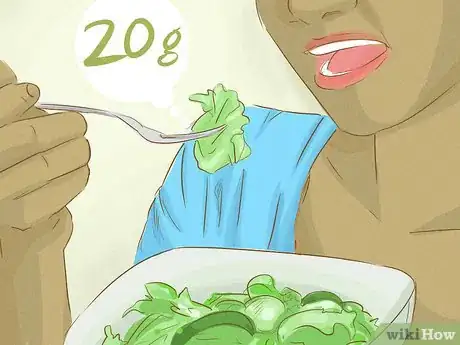




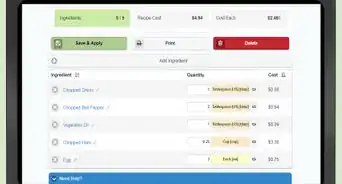
























































Medical Disclaimer
The content of this article is not intended to be a substitute for professional medical advice, examination, diagnosis, or treatment. You should always contact your doctor or other qualified healthcare professional before starting, changing, or stopping any kind of health treatment.
Read More...